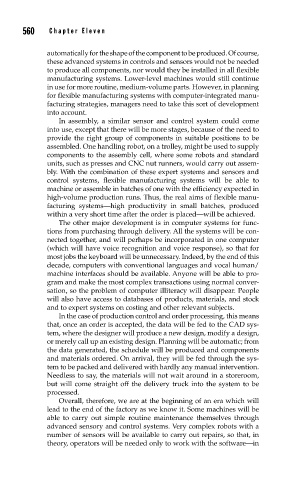Page 607 - Sensors and Control Systems in Manufacturing
P. 607
560
Cha p te r
Ele v e n
automatically for the shape of the component to be produced. Of course,
these advanced systems in controls and sensors would not be needed
to produce all components, nor would they be installed in all flexible
manufacturing systems. Lower-level machines would still continue
in use for more routine, medium-volume parts. However, in planning
for flexible manufacturing systems with computer-integrated manu-
facturing strategies, managers need to take this sort of development
into account.
In assembly, a similar sensor and control system could come
into use, except that there will be more stages, because of the need to
provide the right group of components in suitable positions to be
assembled. One handling robot, on a trolley, might be used to supply
components to the assembly cell, where some robots and standard
units, such as presses and CNC nut runners, would carry out assem-
bly. With the combination of these expert systems and sensors and
control systems, flexible manufacturing systems will be able to
machine or assemble in batches of one with the efficiency expected in
high-volume production runs. Thus, the real aims of flexible manu-
facturing systems—high productivity in small batches, produced
within a very short time after the order is placed—will be achieved.
The other major development is in computer systems for func-
tions from purchasing through delivery. All the systems will be con-
nected together, and will perhaps be incorporated in one computer
(which will have voice recognition and voice response), so that for
most jobs the keyboard will be unnecessary. Indeed, by the end of this
decade, computers with conventional languages and vocal human/
machine interfaces should be available. Anyone will be able to pro-
gram and make the most complex transactions using normal conver-
sation, so the problem of computer illiteracy will disappear. People
will also have access to databases of products, materials, and stock
and to expert systems on costing and other relevant subjects.
In the case of production control and order processing, this means
that, once an order is accepted, the data will be fed to the CAD sys-
tem, where the designer will produce a new design, modify a design,
or merely call up an existing design. Planning will be automatic; from
the data generated, the schedule will be produced and components
and materials ordered. On arrival, they will be fed through the sys-
tem to be packed and delivered with hardly any manual intervention.
Needless to say, the materials will not wait around in a storeroom,
but will come straight off the delivery truck into the system to be
processed.
Overall, therefore, we are at the beginning of an era which will
lead to the end of the factory as we know it. Some machines will be
able to carry out simple routine maintenance themselves through
advanced sensory and control systems. Very complex robots with a
number of sensors will be available to carry out repairs, so that, in
theory, operators will be needed only to work with the software—in

